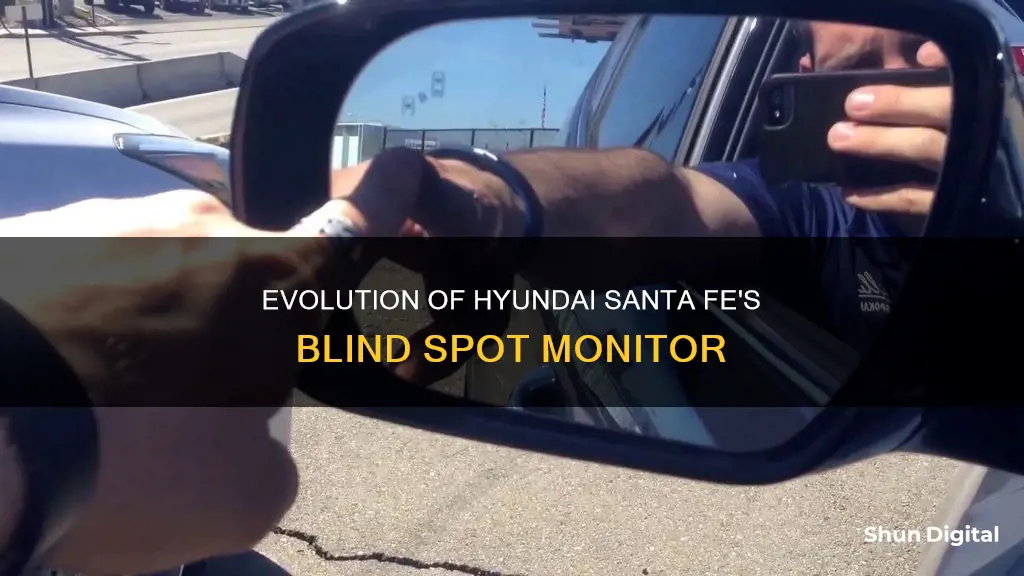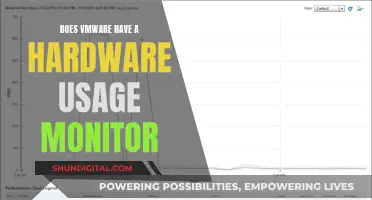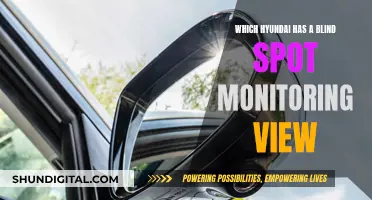
The Hyundai Santa Fe is an SUV that has been in production since 2000. It has since undergone several iterations, with the fourth-generation model offering a Blind-Spot View Monitor as an optional safety feature. This technology, which was first introduced on the Hyundai NEXO in 2018, provides drivers with a rearward view of both sides of the vehicle on a screen within the driver's display. This additional visibility enhances safety when changing lanes and navigating congested highways. The Blind Spot View Monitor is available on the 2020 Santa Fe model and likely on subsequent models as well.
What You'll Learn

Hyundai Santa Fe's Blind-Spot View Monitor
The Hyundai Santa Fe is a rugged yet refined midsize SUV that seamlessly blends the demands of family life with the desire for adventure. The fourth-generation model of this flagship SUV offers one of the best-in-class safety packages, including Hyundai SmartSense™ active safety and driving assistance technologies.
The Hyundai Santa Fe's Blind-Spot View Monitor is one of its standout safety features. This innovative technology was first introduced by Hyundai Motor in 2018 with the NEXO and is now available on the Santa Fe. It provides drivers with enhanced visibility and safety when changing lanes. The system uses wide-angle surround-view monitors on each side of the vehicle to capture areas that cannot be seen by conventional rear- or side-view mirrors. This is especially useful in congested areas or on busy highways, where changing lanes can be challenging and even dangerous. The Blind-Spot View Monitor is activated by the turn indicator, displaying the rearward left and right-hand side views of the SUV on a screen within the driver's display. This feature ensures that drivers have a clear view of any vehicles, objects, or people in their blind spots, helping to prevent collisions.
In addition to the Blind-Spot View Monitor, the Santa Fe also offers other advanced safety features. These include the Rear Occupant Alert, which monitors the rear seats and alerts the driver if passengers are left behind, and the Rear Cross-Traffic Alert – Avoidance Assist, which warns drivers and applies the brakes when vehicles are approaching from the rear side while reversing. The Santa Fe also offers Safety Exit Assist, which prevents accidents by temporarily locking the doors before they are opened, allowing passengers to exit the vehicle safely.
The Hyundai Santa Fe's Blind-Spot View Monitor is a valuable feature for any driver, but especially for those who frequently navigate busy highways or congested areas. This technology enhances safety and provides peace of mind, ensuring that drivers can confidently change lanes and manoeuvre their vehicle with a full awareness of their surroundings.
Smart TV or Monitor: Which Should You Buy?
You may want to see also

How the system enhances safety
The Hyundai Santa Fe is equipped with a Blind-Spot View Monitor, which enhances safety by providing drivers with a comprehensive view of their surroundings. This system uses wide-angle surround-view monitors on each side of the vehicle to capture areas that cannot be seen by conventional mirrors. This technology significantly improves visibility and helps drivers make more informed decisions when changing lanes or merging onto highways.
One of the key benefits of the Blind-Spot View Monitor is its ability to enhance safety in challenging driving conditions. The system provides improved visibility in low-light situations and inclement weather, such as rain. This feature ensures that drivers can still detect vehicles, objects, or pedestrians in their blind spots, even when visibility is reduced. This is especially useful for drivers who frequently navigate busy highways or congested urban areas, where quick and safe lane changes are often necessary.
The Blind-Spot View Monitor in the Hyundai Santa Fe also includes a side-view camera system. When the turn indicator is activated during a lane change, cameras on both sides of the vehicle are activated, providing a clear view of the rearward left and right-hand sides of the SUV. This real-time footage is displayed on a screen within the driver's display, offering a level of detail that traditional mirrors cannot match.
The advanced driver assistance system provides additional safety measures. It alerts drivers to potential risks through visual and auditory warnings, helping them stay aware of their surroundings. Furthermore, the system can detect obstructions in front of the car and provide warnings. If the driver fails to respond to these alerts, the car can take over, applying the brakes to avoid potential collisions.
The combination of enhanced visibility, camera systems, and driver assistance technologies makes the Hyundai Santa Fe's Blind-Spot View Monitor a significant safety feature. It empowers drivers with improved awareness, assists in navigating challenging conditions, and helps prevent accidents, ultimately contributing to a safer driving experience for all occupants and other road users.
Motherboard Monitor Connection: How to Check?
You may want to see also

Other safety features of the Hyundai Santa Fe
The Hyundai Santa Fe has a wide range of safety features. The 2022 model was named an IIHS Top Safety Pick+, and the 2024 model has received a maximum 5-star rating from Euro NCAP. Here is a detailed overview of some of the other safety features of the Hyundai Santa Fe:
Rear Occupant Alert (ROA)
The ROA system acts as an automated alert to detect the presence of a passenger left behind in the rear seat after powering off. This feature earned the Santa Fe a SAFETYBEST award.
Highway Driving Assist 2 (HDA 2)
HDA 2 helps maintain a safe distance and speed from the vehicle ahead on a highway, even on curved roads. It can also change lanes automatically when holding the steering wheel and operating the turn signal switch.
Navigation-based Smart Cruise Control (NSCC)
NSCC helps the driver maintain a safe speed on highways by anticipating safety speed zones, curves, and highway exits or entrances based on the navigation system.
Remote Smart Parking Assist (RSPA)
RSPA allows you to move the vehicle forward and backward when parking in tight locations using the Smart Key buttons.
Forward Collision-Avoidance Assist 2 (FCA 2)
FCA 2 warns you and assists with braking when a collision risk is detected with oncoming vehicles, pedestrians, or bicycles. It can also adjust the steering wheel to reduce the likelihood of accidents.
Lane Keeping Assist (LKA)
LKA prevents unintended lane departure by monitoring road lines with the front camera. When driving above a certain speed limit, LKA automatically guides the driver back into the lane.
High Beam Assist (HBA)
HBA automatically adjusts the high beams by detecting ambient light and illuminance, such as the lights of an oncoming vehicle.
Rear Cross-Traffic Collision-Avoidance Assist (RCCA)
RCCA warns you of a potential collision with an oncoming vehicle on the left or right side while reversing. The system applies the brakes automatically when a collision is imminent.
Reverse Parking Collision-Avoidance Assist (PCA)
PCA warns of a potential collision with a rear object when reversing and automatically applies the brakes when necessary.
Blind-Spot Collision-Avoidance Assist (BCA)
BCA helps detect vehicles in blind spots and provides warnings to prevent collisions when changing lanes or exiting parallel parking spots. The Blind-Spot View Monitor was introduced as an industry-first feature on the Hyundai NEXO in 2018 and is now also available on the Santa Fe.
Palletizing LCD Monitors: A Step-by-Step Guide
You may want to see also

Customer experiences with the monitor
The Hyundai Santa Fe has been recognised across Europe for its safety features, receiving a maximum 5-star rating from Euro NCAP and a SAFETYBEST award for its Rear Occupant Alert technology. The Blind-Spot View Monitor (BSVM) is an innovative safety feature that was first introduced on the Hyundai NEXO in 2018 and has since been added to the Santa Fe. This feature provides drivers with a view of the rear left- and right-hand sides of the SUV on a screen within the driver's display when changing lanes. The system uses wide-angle surround view monitors to capture areas that cannot be seen by conventional mirrors and enhances visibility in low-light and rainy conditions.
One customer who drives a 2020 Santa Fe with the BSVM feature finds it helpful when navigating on and off the expressway. They also appreciate the added bonus of the 360-degree surround view when parking in tight spots. Another customer who drives a Santa Fe with the BSVM agrees that it is a great safety feature, especially when used in conjunction with the side mirror alert and sound alert. However, they note that it takes some time to get used to using it effectively. Similarly, another customer who drives a Santa Fe with the BSVM feature finds it helpful but mentions that it took them about a year to get used to it. They also suggest that it would be useful if the feature could be included in the head-up display area in future upgrades.
Some customers have expressed mixed feelings about the BSVM feature. One customer who drives a Santa Fe with the BSVM finds it helpful but wishes it was included in the head-up display. Another customer who drives a different Hyundai model without the BSVM feature feels that the regular blind-spot detector is sufficient and doesn't think it's worth paying extra for the BSVM. Properly adjusting the side mirrors can also help eliminate blind spots, according to some customers.
Monitoring Data Usage: Netgear Routers and Devices
You may want to see also

How to adjust side mirrors to reduce blind spots
The Hyundai Santa Fe has been recognised across Europe for its innovative and reliable safety credentials. The 2024 model was awarded a maximum 5-star rating from Euro NCAP and a SAFETYBEST award for its Rear Occupant Alert technology. The Santa Fe is the second Hyundai model to be equipped with the innovative Blind-Spot View Monitor safety feature, after the NEXO in 2018.
Blind spots can be dangerous, but they can be minimised by adjusting your mirrors correctly. Here is a guide on how to do this:
Adjusting the Side Mirrors
Lean your head over to the left so that it almost touches the driver's window. Adjust the mirror so that you can just see the rear quarter panel (the rear end of the car) on the driver's side. The rear of your car should occupy less than a third of the mirror. Then, lean your head to the right, keeping your head as close to the centre as possible without leaving your seat. Adjust the right-side mirror so that you can just see the rear quarter panel on the passenger side, which should also take up less than a third of the mirror.
Adjusting the Centre Rearview Mirror
Return to your usual driving position and adjust the centre mirror to see as much of your rear window as possible. You want to see directly out of the rear of your vehicle, so don't tilt the mirror to get a better view of the traffic on either side. The centre mirror should compensate for what the side mirrors can't see.
Confirming the Elimination of Blind Spots
Check the adjustment of your mirrors from a normal, seated driving position. You shouldn't be able to see your car at all in either side mirror, giving you a much wider view. If you can still see the side of your car in either mirror, try the above steps again, adjusting the mirrors to point further outward.
Check the additional view provided by your side mirrors. Your mirrors should now cover more of the lanes next to your car, allowing you to keep track of cars behind you and to the side. While you should still perform a quick shoulder check for safety when changing lanes, you will now have a better view of vehicles and objects to the sides.
Check to ensure objects to the rear transition smoothly to the side mirrors as they pass you. Pay attention to cars passing you. As they approach, you should first see them in the centre rearview mirror. Then, as they pass, they should move laterally through the centre mirror and appear in the corresponding side mirror. This transition should be smooth, with no pause between the vehicle leaving the centre mirror and appearing in the side mirror. This confirms the elimination of blind spots.
Hooking Up Three Monitors: The Ultimate Guide for a Super-Sized Setup
You may want to see also
Frequently asked questions
A blind spot monitor is a safety feature that uses cameras to monitor the blind spots of a vehicle and warn the driver of any potential risks.
Yes, the Hyundai Santa Fe has a blind spot monitor. This feature was introduced to the model in 2018.
The Hyundai Santa Fe uses two cameras, one on each side mirror, to monitor the driver's blind spots. The display will highlight any objects, people, or other vehicles in the blind spot, and the car can even apply the brakes if the driver ignores a warning.
The blind spot monitor has been praised by some drivers of the Hyundai Santa Fe, who have found it particularly useful when driving on congested highways and getting in and out of tight spots. However, others have found that properly adjusting the side mirrors can achieve a similar effect.







